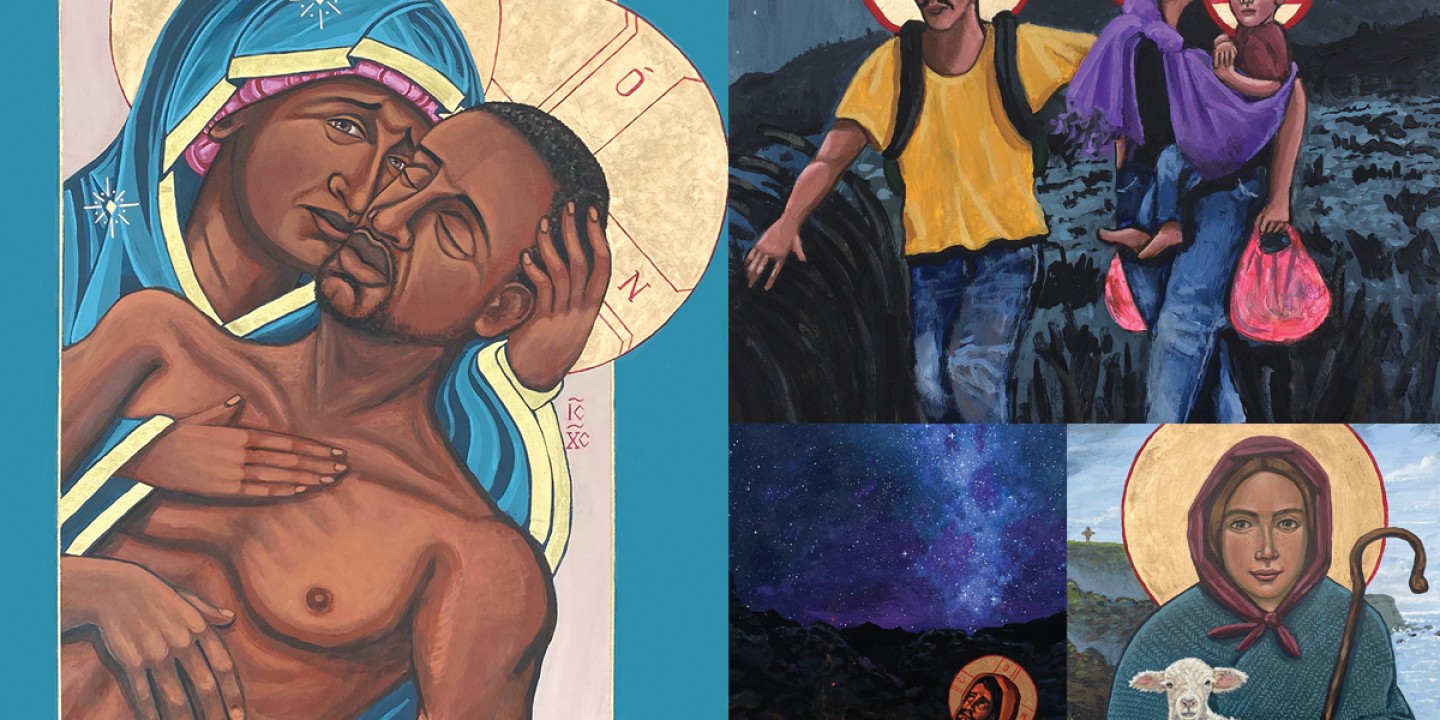Iconographer Kelly Latimore sees God in plain sight
“People asked, ‘Is it George Floyd or Jesus?’ My answer was yes.”

Kelly Latimore has seen his sacred paintings leave the church and march in the streets. In 2020, Black Lives Matter demonstrators in cities across the country held up copies of the 34-year-old artist’s icon Mama, in which a grieving Mary holds the body of Jesus after the crucifixion. It’s a familiar pietà image—except that both figures are Black, and Jesus resembles the late George Floyd, who called out for his mother under a police officer’s knee. Mary’s eyes fix on the viewer, as if asking, “What do you see? Who bears God’s image?”
Latimore, who lives and works in St. Louis, builds on the tradition of iconography in the Eastern Orthodox Church. Like his medieval predecessors, he indicates Jesus and the saints by placing golden discs, or nimbi, behind their heads. But Latimore’s Jesus isn’t European-looking, and his saints are spiritual pathfinders such as civil rights activist and congressman John Lewis, poet Mary Oliver, musician Roebuck “Pops” Staples, and trans activist Marsha P. Johnson—individuals not to worship but to emulate.
Read our latest issue or browse back issues.
Growing up as a preacher’s kid in an evangelical church, Latimore was accustomed to a blond-haired, blue-eyed Jesus; it wasn’t until he went to college that he discovered a wider, richer world of Christian art. He painted—or wrote, in iconographer parlance—his first icon when he was a praying, hoeing member of a monastic farm in Ohio. When a fellow member asked what it meant to consider the lilies of the field, Latimore answered with an image of Jesus holding lilies and looking almost surprised by them.
Latimore’s icon Refugees: La Sagrada Familia, in which the flight to Egypt is interpreted as Latinx immigrants crossing the desert, adorns the cover of Pope Francis’s book A Stranger and You Welcomed Me. But both Refugees: La Sagrada Familia and Mama have triggered hate mail from those who take offense at Christ incarnated as marginalized people of color. To the soft-spoken Latimore, the blowback confirms that his icons are preaching as they should.
When did you start painting?
I’ve always been drawing and painting. When I was a kid, I drew on the church bulletin—pictures of Jesus, Moses, little army men. I’ve never been the most articulate guy. I’ve struggled with words. What I’ve loved about art is that it’s a way of communicating. It wasn’t until I went to Greenville University that it exploded.
I grew up in Aurora, Illinois, in the Chicago suburbs. I was in a place of privilege. My church wasn’t very diverse. I wasn’t seeing people who were poor and homeless. I didn’t have gay friends. After my first year at Greenville, I started taking the train into Chicago and walking around and talking to people. I was trying to get out of that bubble and engage the world. I would take sandwiches, and if someone needed food, I would give it to them and get to know their story. Wandering around Chicago was a catalyst for my art. What are these other images of God in people I haven’t recognized before?
You typically paint your icons on wood, right?
Yes, most of my stuff is on birch because it’s so strong. At the farm, we had a wood stove, and trying to chop birch was like trying to become the Hulk. It was tough to chop. It just doesn’t warp. That’s what you worry about, painting on wood—you don’t want it to warp. I start my icons by priming a 12-by-16-inch board.
What kind of primer do you use?
It’s white gesso, a paint with a bit of glue in it that really adheres to the board. I can sand it down and make it as soft as a baby’s cheek. It’s a nice surface to paint on.
Then I usually sketch right on the board and create the image as I go. I start with the darkest color of the icon and work my way up to the lightest colors. It’s theological—moving from darkness to light.
In the color scheme of traditional iconography, gold symbolizes heaven, white the uncreated light of God, blue the divine life, and red the human life, although some commentators flip the meaning of red and blue. Do you follow that color scheme?
I do. The one I follow the most is the blue and red. In icons, you typically see Jesus in red and blue, both human and divine. In La Sagrada Familia, I put the little boy Mary is holding in a red T-shirt and blue jeans.
Many of your icons break from tradition by including the sky, landscapes, and vegetation. Why is that?
Connecting to the land always has been important to me, especially as a farmer for six years. Having those natural elements gives the icon some groundedness. The sky connects you to the infinite and divine—God is in plain sight, all around us.
Your icons feature a wide swath of public figures, from Martin Luther King Jr. and Mahalia Jackson to Dostoevsky and Flannery O’Connor. What’s your response when people ask why these individuals are saints?
They’re saints because they’re human. They point us to live lives of love and compassion and fight against injustice.
They’re not canonized saints, which isn’t a problem to me. The Catholic Church has this process for who’s a saint that involves miracles. I think it’s a miracle that John Lewis crossed the Edmund Pettus Bridge, got beat over the head, and kept going.
How did Mama come about?
It was commissioned by my partner Evie Schoenherr as a way to mourn George Floyd. In my first sketch, Mary was looking at the savior, but we ended up shifting her gaze to the viewer. It was Evie’s idea. That subtle shift was powerful. It wasn’t focusing on the death, which was horrible, but the viewer, and guiding us to communal thought and prayer and action.
There were so many voices that went into that icon. In the Black community, there’s dialogue about whether continuously showing dead Black bodies is healthy. I worried about that. But several Black friends of mine told me this was needed—God being present in the dead Black body—as a way to respond so this doesn’t keep happening.
I think Mama encapsulates my favorite part of iconography, the communal aspect. It makes the artist part of the community, part of the whole.
What’s the history of Refugees: La Sagrada Familia?
It was the first icon I painted after Trump was elected. It was based on traveling with Evie and encountering some undocumented immigrants. We were sitting around a bonfire one night with this young man from Guatemala who told us why he was in the United States, his struggles, his hopes and fears. He had come here as a teenager, only to be deported and then almost beaten to death in Mexico. He eventually crossed the desert again to the United States, and along the way he saw remains of women holding babies. Everything about him broke us. So that icon is confident that he is beautiful as a person. He has the image of God within him.
I’ve been conscious of how the evangelical church was supporting these abuses of children in cages by supporting Trump. A lot of America is anti-immigrant, anti-stranger. I’m trying to use icons to help people to see in a different way
Some Christians have written to me that Joseph and Mary weren’t really fleeing their homeland when they went to Egypt because it was part of the Roman Empire, like Palestine. So it would be like fleeing from Indiana to Illinois. My response was, “Buddy, you’re missing the point.”
Who’s sending you the hate mail?
Most of the death threats and spiritual denunciations have come from Eastern Orthodox individuals in Russia and Ukraine. I get those once or twice a week about Mama. Like, “Throats will be cut because of this heresy.” Versions of “You’re going to hell.”
Is this hate mail racist?
I think race is part of it. Racism is a complete denial of the incarnation.
The common question that people asked was, “Is it George Floyd or Jesus?” The fact they’re asking that question is part of the problem. My answer was yes. This nonanswer frustrated the hell out of a lot of people. Again, it’s them trying to protect God, and we can be pretty sure that when we try to protect God, we’re creating an idol.
What have been some of the positive responses to your icons?
People of color who see my icons of Jesus will say, “I appreciate that you didn’t make him White.” People are looking for new representations of the imago Dei in the here and now.
A monk from South America said his family traveled to the United States and handed him off to his grandmother when he was a little boy. He said he saw himself depicted in La Sagrada Familia.
Icons used to be called a Bible for the illiterate. In countries such as the United States where the literacy rate is very high, this role for the icon seems less necessary. So what role is it serving?
I think what it means to be human and an artist is to be present. Not only to your craft, but also to the world around you. And I think what happens in an information culture, which is mainly literate, is that we’re very quick to judge and assume and speak into things we rarely observe. We’re inundated with advertising, social media. We have so many images flashing before us. I think what art can do for us now is force us to pay attention. When you pay attention to one thing, you resist paying attention to something else. With icons, we’re saying, “These are important images. This is what we are choosing to see.”
Hopefully the icon can be something that opens us up to the “other,” the thing we don’t know. Language, knowledge, and theology will only get you so far.
A version of this article appears in the print edition under the title “Seeing God in plain sight.”





